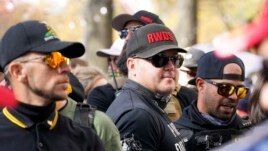09 May 2023
Mauricio Garcia killed eight people and hurt many others when he shot into the car parking area outside a shopping center near Dallas, Texas on Saturday.
News reports say Garcia showed signs of extremism and had permanent pictures and letters painted on his skin. These images are called tattoos. He also wore the letters "RWDS" on a part of his clothing.
The tattoos are described as "Nazi." The term comes from the name of the party that controlled Germany under Adolf Hitler in the 1930s and 40s and is linked with racial hatred and violence. Reports say Garcia put information online suggesting that he was interested in Nazi images and white supremacist ideas.

FILE - People identifying themselves as members of the Proud Boys joined a march on Nov. 14, 2020, in Washington. The gunman who killed eight people on Saturday, May 6, 2023, at a Dallas-area mall was also wearing a "RWDS" patch. (AP Photo/Jacquelyn Martin, File)
But many people might not know what the letters "RWDS" mean.
The Associated Press recently reported on the meaning of the letters, or acronym:
Extremism experts say RWDS stands for "right wing death squad."
Oren Segal is vice president of the Center on Extremism at the Anti-Defamation League, a nonprofit group based in New York City. The group fights antisemitism, extremism and hate.
Segal said the term first appeared in the 1970s and 1980s when people were describing paramilitary groups that killed the political opponents of dictators in Central and South America.
The term reappeared about 10 years ago when extreme American groups of the political right started to use RWDS to express their opposition to the extreme political left "more broadly," Segal said.
Heidi Beirich is co-founder of the group Global Project Against Hate and Extremism, a nonprofit based in Montgomery, Alabama. She said the group in the U.S. called the Proud Boys started using the letters most often.
Photos of Proud Boys leaders have shown them wearing the letters.
But the Anti-Defamation League said the Proud Boys are not the only ones to wear the RWDS letters. Some people were wearing them in Charlottesville, Virginia in 2017. In August of that year, a white pride rally turned violent, and one woman was killed.
The New York Times newspaper said social media service Facebook banned groups that used the RWDS acronym after the death in Charlottesville.
But one expert said the letters and the phrase "right wing death squad" are being used more often.
Jon Lewis is a researcher for the Program on Extremism at George Washington University in Washington, D.C.
He called the letters "a rallying cry" and said they "cut across and far beyond any individual group." Lewis said the groups look favorably on dictators such as Chile's Augusto Pinochet who died in 2006. He said the groups want to use the powers of government to carry out "violent genocide" against opponents.
One professor said that people who wear symbols and acronyms like RWDS do not always know what they mean and where they come from.
Cynthia Miller-Idriss is director of American University's Polarization and Extremism Research and Innovation Lab in Washington, D.C. She said something like RWDS spreads on social media. While "nobody is accidentally going to have a ‘Right Wing Death Squad' patch," she said, "they don't always know exactly" what it means.
People might wonder why a person named Mauricio Garcia, who was Hispanic, would support white supremacist ideas.
Enrique Tarrio, a former Proud Boys leader, is Cuban-American. Miller-Idriss said people who do not consider themselves to be white can still be interested in white supremacist ideas. She said it is the same for women who support "male supremacist movements."
Tanya Hernandez is a professor at Fordham University in New York City. She wrote a book about Latinos who have unfair ideas about Black people.
She said Latinos are often seen as "unwanted others" in American society. But they want to find a way to fit in. So, Hernandez said, "what better way to make a claim...than to be part of the enforcement, the policing of whiteness within a white supremacist hate group?"
I'm Caty Weaver. And I'm Dan Friedell.
Dan Friedell adapted this story for Learning English based on a report by the Associated Press.
_________________________________________________________________
Words in This Story
tattoo –n. pictures or words permanently written on a person's skin with ink
Nazi –n. a member of the National Socialist German Workers Party which ruled Germany from 1933 to 1945; an insult used to say a person is very bad
white supremacist –n. a person who believes that the white race is better and should rule other races
anti-semitism –n. the hatred of Jewish people
broadly –adv. widely
pride –n. a feeling of self-importance
rally –n. a public meeting to support a cause or person
symbol –n. any sign or image that represents another idea or belief
patch –n. a small piece of cloth that is placed on clothing